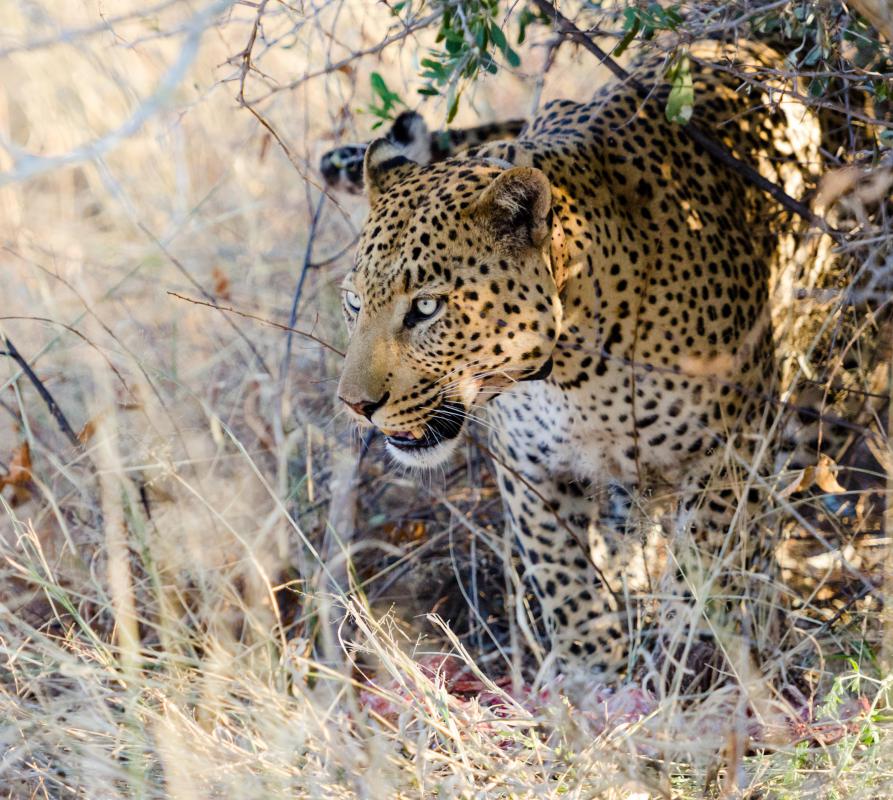At AllThingsNature, we're committed to delivering accurate, trustworthy information. Our expert-authored content is rigorously fact-checked and sourced from credible authorities. Discover how we uphold the highest standards in providing you with reliable knowledge.
What is a Cheetah?
Cheetahs are unusual felines that live in Africa. At one point, their range extended across India and the Middle East. The cheetah is a streamlined cat that weighs between 40 and 65 kg (88 to 140 lb) and is about 1 m (3.2 ft) in length, excluding its tail. Cheetahs are covered in a beautiful black-and-orange spotted pattern, and their name (derived from Sanskrit) means "variegated body."
Cheetahs are most famous as the world's fastest land animal. Cheetahs can run as fast as 120 km/h (75 mph) for short bursts of up to 460 m (1500 ft). They hunt fast animals such as gazelles and the impala, occasionally taking the young of larger animals such as wildebeests and zebras. During a chase, a cheetah's respiratory rate increases from 60 to 150 breaths per minute. Its body is adapted for sprints, featuring an enlarged heart and lungs. Cheetahs can go from a standstill to 70 mph in three seconds, better than most high-end sports cars.

Cheetahs are sufficiently different from other felines that they are given their own genus, Acinonyx. Unlike most other cats, cheetahs lack climbing ability, and rely entirely on speed for hunting prey. Prey that is able to get into a tree can therefore escape, but the gazelles that cheetahs hunt lack climbing ability as well.
Like lions, whose range they overlap, cheetahs are highly social and hierarchical. Males maintain territories between 37 and 160 square kilometers in extent, depending on the availability of food in the local area. Rather than going at it alone, males make friends with a few others and cooperate in a unit called a coalition. Studies have shown that coalitions are about six times more likely to maintain territories than lone males.

Unlike the male cheetah, the female cheetah does not maintain territories, and instead has a home range which may be significantly larger than a typical male territory. Males try to pick territories where several female home ranges overlap, so as to maximize its chances of reproduction.
The cheetah is sometimes considered a "big cat," sometimes not. Technically, a big cat should be able to roar, like tigers, lions, leopards, and jaguars, but a cheetah cannot. A cheetah is also significantly smaller and weaker than those big cats, though it is far larger than a house cat. Instead of roaring, cheetahs use other vocalizations to communicate, such as chirping, churring, growling, yowling, and purring. Because their natural range has been so sharply restricted due to human encroachment over the last few hundred years, the cheetah is currently considered a vulnerable species. There are about 12,400 cheetahs in the wild.
Frequently Asked Questions
What distinguishes a cheetah from other big cats?

Cheetahs are renowned for their exceptional speed, capable of reaching up to 60-70 miles per hour, making them the fastest land animals. They have a slender, aerodynamic body, long legs, and a long tail that helps with balance during high-speed chases. Unlike other big cats, cheetahs cannot roar; they communicate with a variety of vocalizations like purrs and chirps.
How do cheetahs hunt their prey?
Cheetahs utilize their incredible speed to chase down prey in short bursts, often targeting smaller antelopes such as gazelles. They rely on stealth and camouflage to get close before the chase, using their keen eyesight to spot prey from afar. After a sprint, they use their dewclaw to trip their prey before delivering a suffocating bite.
Where can cheetahs be found in the wild?
Cheetahs primarily inhabit the savannas and grasslands of sub-Saharan Africa, with a small population in Iran. They require vast expanses of land with sufficient prey and minimal cover to facilitate their high-speed hunting. Habitat loss and fragmentation have significantly reduced their range and numbers in the wild.
What is the social structure of cheetahs?
Cheetahs are generally solitary animals, with females living alone except when raising cubs. Males may live alone or in small groups, often with their brothers from the same litter. These coalitions help males defend territories and increase their chances of mating. Mothers are highly invested in teaching their cubs survival skills over a period of about 18 months.
What are the main threats to cheetah populations?
The cheetah faces several threats, including habitat loss due to human encroachment, conflicts with farmers, poaching, and a decline in prey species. Their low genetic diversity also makes them susceptible to diseases. Conservation efforts are crucial to address these threats and ensure the survival of this iconic species.
How are conservationists working to protect cheetahs?
Conservationists are employing strategies like habitat restoration, establishing wildlife corridors, and working with local communities to mitigate human-wildlife conflict. Programs that incentivize the protection of cheetahs and their habitat are also in place. Breeding programs in captivity and scientific research contribute to the understanding and preservation of cheetahs in the wild.
AS FEATURED ON:
AS FEATURED ON:













Discussion Comments
@calabama71: Cheetahs care for their young as well as most. Sometimes the male will accompany the female for a short time after they mate but, more often than not, the female is alone or with her cubs. She usually gives birth from 2 to 4 cubs at a time and they are born in a secluded area.
The cubs' eyes do not open for a couple of weeks and they are totally helpless at first, just like kittens. When the mother goes out to hunt, she will hide the cubs. By about 6 weeks of age, they can follow her while she hunts. They nurse for about 3 months but they start eating meat from around 3 weeks of age.
Sadly, there is a lot of disease among the cheetahs and, in some areas, 50 to 75 percent of all cubs die before they reach 3 months of age.
Do cheetahs have good parenting skills?
Post your comments